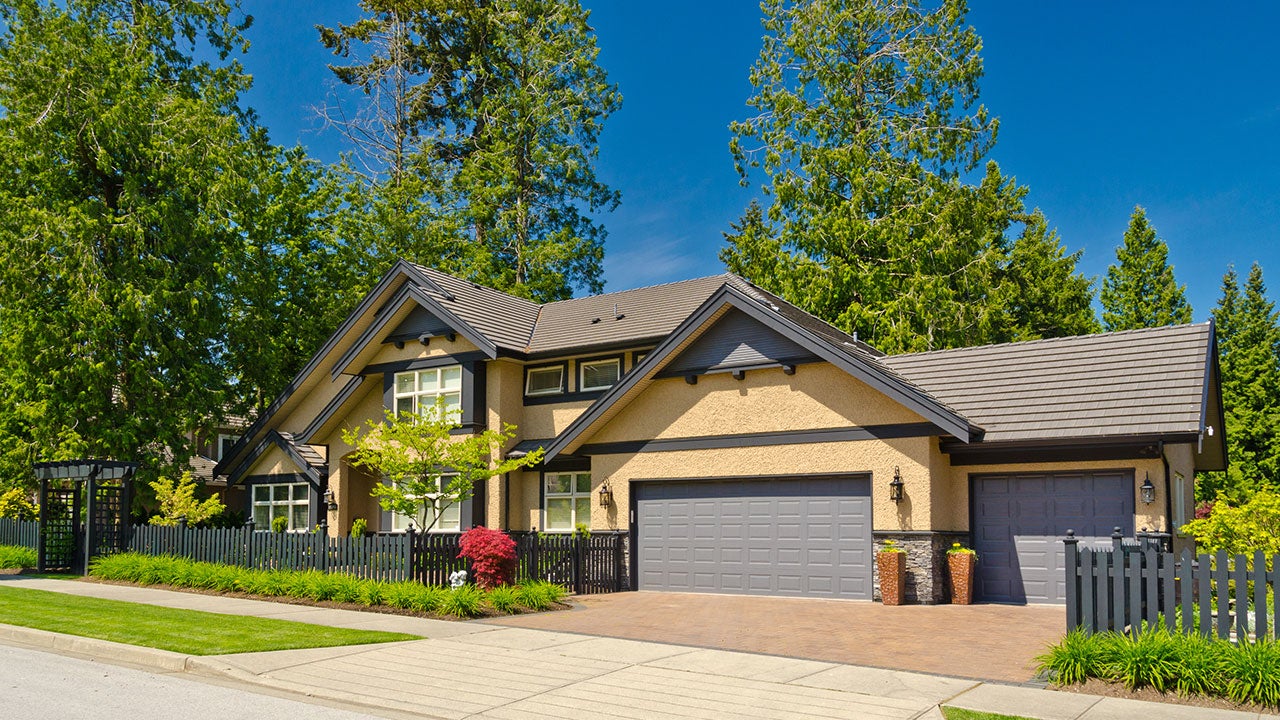Guide to FHA adjustable-rate mortgages

Key takeaways
- An FHA adjustable-rate mortgage is an FHA loan with a fixed rate for a specific period, then an adjustable interest rate for the remainder of the loan term.
- After the fixed-rate period, an ARM’s rate adjusts at set times and could be higher or lower than the initial rate.
- An FHA ARM might be a good option if you have a low credit score and are seeking a lower initial rate, plan to sell within a few years or anticipate a substantial increase in income.
What is an FHA adjustable-rate mortgage?
An FHA adjustable-rate mortgage is a home loan insured by the Federal Housing Administration (FHA) that comes with a fixed interest rate to start before converting to an adjustable rate that can shift up or down for the remainder of the loan term.
FHA home loans are offered by FHA-approved mortgage lenders. These loans are geared toward lower-credit-score borrowers, including first-time homebuyers, who often wouldn’t qualify for a conventional loan. FHA loans only require a 3.5 percent down payment but mandate the borrower to pay mortgage insurance premiums (MIPs). They also limit how much you can borrow.
FHA loan rates often run lower than conventional mortgages too, but sometimes the presence of their various fees (including the MIPs) actually makes their APRs higher.
How do FHA ARM loans work?
An FHA adjustable-rate mortgage works similarly to other adjustable-rate mortgages: The interest rate initially remains the same for a set time, then changes at preset times until the borrower fully repays the loan.
These changes are based on an index of prevailing interest rates — for FHA loans, either the Constant Maturity Treasury (CMT) index or the Secured Overnight Financing Rate (SOFR) — plus a margin, or extra amount, that the lender opts to add on. After the loan’s initial fixed period ends, the lender adds this margin to the index to develop new rates. The adjusted rate might be higher or lower depending on current economic conditions and prevailing interest rates.
However, your rate can’t increase or decrease beyond a specific amount. On ARM loans, there are both annual and lifetime caps, which limit annual rate changes, as well as changes over the loan’s entire term.
FHA ARM loan rates
ARMs’ introductory rates tend to be lower than those of fixed-rate loans. As of June 23, 2025, the average interest rate for 5/1 ARM loans is 6.08 percent, compared to the average rate of 30-year fixed-rate mortgages at 6.83 percent, according to Bankrate’s survey of national large lenders. Even a 7/1 ARM loan has an interest rate of 6.28 percent.
When comparing FHA ARM offers, consider the introductory rate along with the lender’s margin. Generally speaking, the lower the margin, the better.
With rates rising, consider the type of FHA ARM, as well. The one-year and three-year ARMs, for example, have lower caps, meaning you won’t see as big of a jump in your rate if prevailing rates do go up in the future.
FHA ARM loan requirements
Borrowers and the homes they wish to buy must meet certain FHA loan qualifications, including:
- Acceptable properties: Primary residences
- FHA loan limit: For 2025, $524,225 for a one-unit property; $1,209,750 for a one-unit property in high-priced housing markets
- Credit score: At least 580, or as low as 500, with a bigger down payment
- Debt-to-income (DTI) ratio: 43 percent for housing and other long-term debt (some lenders may go up to 50 percent if the borrower has compensating factors), and 31 percent for just housing debt
- Down payment: 3.5 percent with a credit score of 580 or higher; 10 percent with a credit score of 500 to 580
- Employment: Proof of steady employment from the past two years
- Income: Latest pay stubs along with proof of any bonuses, commissions, etc., if consistent
- Mortgage insurance premiums (MIP): 1.75 percent of the amount borrowed at closing, plus annual premiums based on the amount borrowed, down payment and loan term (15 or 30 years)
If your credit history is lacking, especially in handling debt, the FHA now allows lenders to include a borrower’s rental payments in their underwriting assessment, as well. You must be able to show proof you’ve paid your rent on time every month for the past year.
Types of FHA ARM loans
There are five kinds of FHA ARM loans:
- 1-year FHA ARM: Your interest rate stays the same for the first year of the loan’s term. After that, the rate can only increase by one percentage point (for example, 5.5 percent to 6.5 percent) per year and five percentage points for the life of the loan.
- 3-year FHA ARM: Your interest rate stays the same for the first three years, but the caps are the same as the 1-year ARM.
- 5-year FHA ARM: Your interest rate stays the same for the first five years. After that, the rate can only increase annually by one percentage point, and by five percentage points over the life of the loan; or by two percentage points annually and six percentage points over the life of the loan.
- 7-year FHA ARM: Your interest rate stays the same for the first seven years, then can adjust by up to two percentage points per year and six percentage points over the life of the loan.
- 10-year FHA ARM: Your interest rate stays the same for the first 10 years, but the caps are the same as the 7-year ARM.
There is also a difference between standard and hybrid ARM loans. The FHA has four hybrid ARM loan products. These hybrid loans have a fixed introductory rate for a set number of years (3, 5, 7 or 10), after which the rate will adjust after a set period for the remainder of the loan term.
Pros and cons of FHA ARM loans

Pros
- Attractive introductory interest rates
- Easier to qualify for if your credit needs work
- Gets you into a home sooner thanks to a lower down payment and more affordable monthly payment

Cons
- Risk of future increases to your rate, which can make monthly payments unaffordable, potentially forcing you to sell the home and move or increasing your risk of foreclosure
- Need to refinance to remove mortgage insurance premiums
- Limited to buying a home with a mortgage within loan limits and for use as a primary residence
Alternatives to FHA ARM loans
An FHA mortgage is not your only option. Some alternatives to FHA ARMs that can help you buy a home include:
- HomeReady mortgage: Fannie Mae‘s HomeReady program requires a minimum 620 credit score. You do not have to be a first-time homebuyer, but you will need an income lower than 80 percent of the area median income. You’ll also need to take a homeowner’s education course.
- Standard 97 Home Loan: Also provided by Fannie Mae, this mortgage requires 3 percent down, and at least one borrower must be a first-time homebuyer.
- HomeOne Loan: Freddie Mac offers the HomeOne Loan for first-time homebuyers, and it has no income or geographic limits. You can put down a minimum of 3 percent on a home with this loan.
- Home Possible Mortgage: Also offered by Freddie Mac, the Home Possible mortgage is a loan option for very low- to low-income homebuyers. You must meet qualifying income limits: no more than 80 percent of the area median income.
These mortgages are for primary residences only, so you will need to look at other options should you require a mortgage for a second home or investment property.
Refinancing an FHA ARM
Many borrowers refinance before the first ARM rate reset. You might want to refinance out of an ARM loan into a fixed-rate one if rates have dropped since you first obtained the loan and you want the stability of a non-fluctuating rate. You can also refinance to another ARM.
If you qualify, you might want to refinance from an FHA mortgage to a conventional loan, too. This allows you to eliminate (or work toward eliminating) mortgage insurance premiums, as conventional loans only require insurance if you have less than 20 percent equity in your home. In contrast, most FHA loans require you to pay insurance for the entire loan term, regardless of how much you’ve paid down the mortgage.
Keep in mind: Refinancing is typically only worthwhile if you can get a lower rate and pay the closing costs. If you won’t live in the home long enough to recoup those costs and realize the savings, it might not make financial sense.
Should you get an FHA adjustable-rate mortgage?
There are scenarios in which getting an FHA ARM might be a good move:
- You’d be able to afford buying a home: If getting a lower initial interest rate will help you afford a home, choosing an FHA adjustable-rate mortgage can be a good option — as long as you factor in your ability to afford potentially higher payments later.
- You only plan to own your home for a couple of years: You can take advantage of the lower introductory rate and then sell your home before the rate adjusts.
- You expect to be able to afford a higher payment in the future: For example, a future raise or promotion could mean an increase in earnings, enabling you to afford a higher mortgage payment later.
Why we ask for feedback Your feedback helps us improve our content and services. It takes less than a minute to complete.
Your responses are anonymous and will only be used for improving our website.









